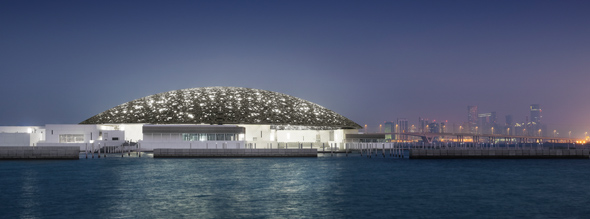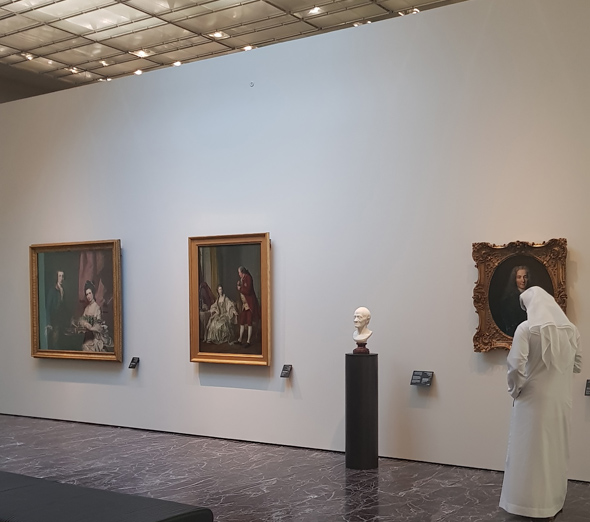WATCH: A first look inside The Louvre Abu Dhabi
It opens this Saturday November 11: here’s what to expect…
After 10 years in the making, the Louvre Abu Dhabi opens to the public this Saturday – but we got to take a first look inside. This is what we saw…
Here’s a guide…
THE BACK STORY
The Saadiyat Island art museum opens 10 years after the French and Abu Dhabi governments signed an unprecedented agreement to launch the Louvre brand in the UAE. The aim behind this was to bring a “universal museum” to the Arab world. The agreement gives the UAE museum the right to use the Louvre name for 30 years and 6 months.
THE BUILDING & AREAS
The most talked-about element of the Louvre Abu Dhabi so far has been the architecture, which was spearheaded by French architect Jean Nouvel. Its stand-out feature is the huge, 7,500-tonne dome roof (it weighs about the same as the Eiffel Tower).
“It is rather unusual to find a built archipelago in the sea,” explains Nouvel. “It is even more uncommon to see that it is protected by a parasol creating a rain of light.”

Image: Mohamed Somji
“It is both a calm and complex place… It is a project founded on a major symbol of Arab architecture: the dome. But here, with its evident shift from tradition, the dome is a modern proposal.”
The dome is 40 metres above sea level at its highest point, and sits atop 55 individual buildings that make up the Louvre (almost mimicking the ambling planning of places like Bastakiya). Of these 55 buildings, 26 are permanent individual galleries.
There is also a children’s museum with interactive events, a restaurant, a cafe, a gift shop and an ocean-view auditorium (where the performers sit in a sort of floating island/stage).
The cafe will be open by Saturday (you need a museum ticket to visit it), and the restaurant will open in a few months’ time. There will also be interactive workshops held at the museum throughout the year.
THE OPENING WEEK EVENTS
Online tickets for the opening day are already sold out, so organisers are encouraging visitors to book in advance for another day if they’re keen to visit soon. Also, there will be four days of live entertainment to celebrate the museum’s opening – you can read all about those peformances here.
THE MUSEUM
There are 6,400 square metres of permanent galleries at the Louvre Abu Dhabi – and at the moment you can see 235 works from the Louvre Abu Dhabi’s own collection and 300 works on loan from French museums.
The exhibition spaces are mostly split by time rather than geography, so you can see a slice of the world during any given era as you move through it, which is exceptionally cool (and enlightening).
The first room is called The Great Vestibule, and it presents three similar objects from around the world that each highlight the surprising similarities between early civilisations (for instance, you’ll find three golden death masks, three reliquaries, three maternity figures etc). This room aims to spark a visitor’s interest, and to get them to think about history and art from a truly global perspective.
*ALSO READ: 15 pieces you’ll be able to see in the Louvre when it opens*
The museum’s narrative is broken into 12 chapters that give the visitor a global glimpse of the past 12,000 years on earth, these are:
– The First Villages

Focuses on community settlements in 10,000 BCE, with pieces from Jordan, Central Asia, Central America and more.
– The First Great Powers

Image: Louvre Abu Dhabi/Thierry Ollivier
A look at the first kingdoms that sprouted up in the fertile valleys of Tigris, Euphrates, Nile, Indus and Yellow river around 3,000 BCE – a time when bronze weapons changed our world, as did warriors on horseback. This area also houses a phenomenal coffin and mummy’s wrapping from 950 BCE.
– Civilisations and Empires
This sections focuses from around 1,000 BCE, when kingdoms transformed into politically driven civilisations – it was during this period that Alexander the Great forged a union between Europe and Asia and the Han Empire expanded across China. There are pieces from Egypt, Nigeria and more to be found here.
– Universal Religions

Image: Louvre Abu Dhabi/Thierry Olivier
Follows the spread of monotheistic religions around the globe around 2,000 years ago – this area features religious icons, as well as an ancient Qur’an, Torah and Bible.
– Asian Trade Routes
Follows the silk trade route from China through to the Arab Muslim world, starting around the 7th century. Here you’ll find a large Ushak carpet from 1480.
– From the Mediterranean to the Atlantic
From the 11th Century, exchanges increased between the Byzantine Empire, the Islamic World and Christian Europe – this time period also saw the crossing of the Atlantic and the first contact between Europe and the Amerindian civilisations.
– The World in Perspective

Image: Musée du Louvre, C2RMF/T.
The 15th century: A time of pioneering voyages and discoveries in mathematics and optics in the Arab World forming the use of geometry and the abstract in Islamic art. This was also the time of the Renaissance in Europe – and in this exhibition you’ll see Leonardo da Vinci’s La Belle Ferronniére.
– The Magnificence of the Court
The 17th century: A time when rulers began commissioning majestic representations of their courts and power, and monarchs competed to commission the best artists.
– A New Art of Living
The 18th century: The era of the individual and a time when affluence spread out to a larger portion of society and greater attention was paid to furnishing and clothing. This is when the arts grew from the public sphere into the private realm.
– A Modern World?
The 19th century: A time when transportation and colonisation transformed the world, and inspired artists. This was also when photography took on an important role in the art world: eliminating distance between the viewer and the subject.
– Challenging Modernity
The 20th century: Two World Wars and decolonisation meant this was a period of questioning, giving birth to the abstract and the surreal. Here you’ll see Piet Mondrian’s Composition with Blue, Red, Yellow and Black.
– A Global Stage
The 21st century: Communications transforms our earth into the illusion of a ‘global village’ – we now live in a multipolar, and multi-continental world, and this exhibition space reflects that. The art focuses on collective identity issues and our fears about our fragile planet.
TICKETS AND VISITING

The Louvre Abu Dhabi will be open from 10am to 8pm Saturdays to Wednesdays and 10am to 10pm Thursdays and Fridays. It will be closed on Mondays.
There’s a lot to take in, and we’d suggest at least half a day to absorb it all (we actually think splitting it up into two visits would be a good idea, and that’s what we’re planning on doing).
Those aged 13 and under can enter for free to help encourage the next generation of art lovers, as can people of determination (plus one accompanying companion); regular adult tickets cost Dhs60, and tickets for those aged 13 to 22 cost Dhs30.
You can also opt for museum membership – for Dhs450 you’ll get an annual pass for you plus one.
There are also guided tours that you can add on to your ticket. There is ample parking available, including a valet option, and there will also be a taxi queue.
There’s a coat and luggage check inside the museum.
You can buy tickets online at louvreabudhabi.ae (but this Saturday is sold out).
Saadiyat Cultural District. Tel: (600) 56 55 66. More info on website.
– For more about Abu Dhabi straight to your newsfeed, follow us on Facebook.
